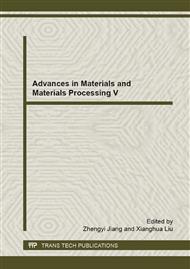p.820
p.824
p.828
p.833
p.837
p.842
p.846
p.851
p.855
Research on Stable Forming of Titanium Alloy Bar Using Three-Roll Skew Rolling
Abstract:
Titanium alloy with high strength, corrosion resistance, heat resistance and many other advantages has widely applications in aviation industry and the military-industrial complex. The market demand for titanium alloy increases year by year. However, the rolling technology for small size titanium rod is not mature due to its poor plasticity and difficult processing. In addition, current titanium alloy bar can not meet the high-end market requirements, it still largely dependents on imports now. Developing high-quality titanium bars is a major aim of titanium industry in our country in the future. Three-roll rolling is one of mature methods in current production of titanium alloy bars. Using this processing method for rolling titanium alloy bars, multi-standard, low-volume production requirements can be achieved.
Info:
Periodical:
Pages:
837-841
Citation:
Online since:
March 2015
Authors:
Keywords:
Price:
Сopyright:
© 2015 Trans Tech Publications Ltd. All Rights Reserved
Share:
Citation:


